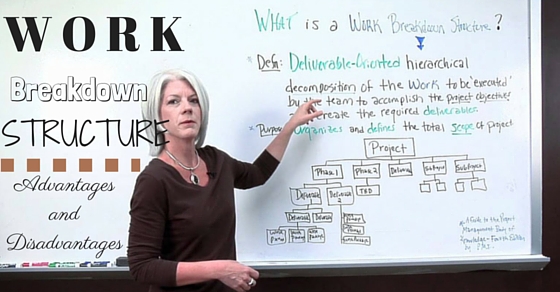Good project managers will always make it a point to breakdown the tasks, deliverables and activities that are related to the project into chunks that are manageable and can be used at work.
This will also allow the team members to understand what is needed and what must be done in order to get the desired results.
However, there are some disadvantages that come with the work breakdown structure. Keep reading to find out what they are, how can you implement this at your workplace and what should you consider before making use of this approach.

Before we tell you about the advantages and disadvantages of a work breakdown structure, here is a quick definition and other details regarding it.
What is Work Breakdown Structure (WBS)?
A work breakdown structure in every project management and system engineering is an effective tool that is used for defining and group the discrete elements of work in any project so that it can help the organization, build it in some way and boost the work scope of the whole project.
The WBS method of management has a proper team and manager with a good set of tasks which create the regular cost estimates and give you some important input to every project in all levels possible.
When we use the work breakdown structure method, the project manager and his team members will have a great idea on what is good and what isn’t. It will depend on the requirements of the project that is needed to finish the job.
Purpose of WORK BREAKDOWN STRUCTURE (WBS):
You might be thinking “Why do we have to create a work breakdown structure for our project?” then the right answer for it is that it serves a great purpose.
The purpose of using WBS in projects has been compiled into 3 main points, which are mentioned below. They are
1. It helps you specifically define, assemble and cover the overview of the whole project.
2. Helps in managing the whole project by monitoring, assigning responsibilities, allocating resources etc
3. The final step is to cross-check every part of the specifics and make sure that nothing is missing.
How to Create a Work Breakdown Structure?
The term work breakdown structure defines itself. It is a process of segmenting the whole project into different parts which help you manage them easily and assigning it to teams accordingly. This also helps the team as they do not get stressed and can complete the work on time.
Before proceeding, let us have a look at few rules of creating a WBS
Rules to create a work breakdown structure:
- The completion of the whole project needs to be our goal.
- The task once completed should not be included twice.
- The focus should be only on outcomes and not on actions.
- A work assigned should be completed with no more than 80 hours and no less than 8 hours of effort.
- Incorporate the details of all the three levels.
- Assign each task to a specific team or individual.
Some of the inputs which you will require to create a Work Breakdown Structure are,
- The Project Scope Statement
- The Project Scope Management Plan
- Organisational Process Assets
- Approved Change Requests
Tools required :
- Work Breakdown Structure Templates
- Decomposition – (PMBOK Guide)
Now the combination of the above-mentioned inputs and tools would give rise to the following results or output.
- Work Breakdown Structure
- WBS Dictionary
- Scope Baseline
- Project Scope Statement (updates)
- Project Scope Management Plan (updates)
- Requested Changes
So, the first step is to understand the whole project completely and to get an overview of the objective to be achieved. Next, you need to segment the total project into different parts. The type of project would help you split it into separate work packages or tasks. The next step would be sorting and assigning each work package to each team or individual accordingly.
This helps in the completion of the whole project on time and the objective can be achieved successfully.
Work Breakdown Structure Formats:
The work breakdown structure can be formatted into different forms. You need to choose the type of format as per your choice and also on the nature of the project. These formats help you in understanding the whole project management process from the beginning till the last step.
Some of the different WBS formats are,
- Tree format
- Outline structure
- Hierarchical structure
- Tabular structure
Work Breakdown Structure Importance:
The most important feature of a work breakdown structure is beneficial to the project managers as they can perform their work in a more organized and well-planned manner. They would be responsible for scheduling, fixing the price, categorizing the works and assigning to the teams.
Moreover, the final objective is to complete the task on time and to meet the needs and requirements of the stakeholders. So, the WBS helps to make a work or project execution effective.
Here are the areas in which the work breakdown structure works,
- Tasks
- Costs
- Schedule
- Scope
- Function
- Responsibility
Major Benefits of Work Breakdown Structure:
The method of WBS is understood and used mostly by project managers since they happen to be the founder of planning projects. This may not be surprising considering the fact that there are a few benefits which could be gained from having a proper and well-written breakdown of the work structure. If you are hoping to introduce this method soon at your workplace, this is what you should know.
1. Boosts productivity:
The structure of work breakdown will boost productivity at your work place. It facilitates the identification of skills which are needed to finish assignments on time. That, in fact, could boost the determination of people needed for the job.
Also, it will boost the determination of the best number of people who are needed for work completion.
By having the right set of people and the right number of them on the job, the members of your team, in general, could help others become even more productive.
This may result in giving away the correct deliverables within time and set the needed costs which sometimes may exceed expectations.
2. Has detailed steps:
The structure of work breakdown will allow the team members to see the delineation of steps which are needed in giving the right products and service to all stakeholders.
The team members shall be able to understand all relationships between deliverables and steps. Plus all the discussions which are related to the delineation of steps can help a lot when it comes to handling ambiguities and clarifying them, narrowing the scope of projects and bringing out those assumptions which may often lead to increasing critical issues that may affect the performance of your team in an adverse manner.
3. Boosts transparency and accountability:
The structure of work breakdown will provide for a much level of details which will make it easy for those who are managing the projects. It will also let him understand his team members and hold them responsible for all tasks that have been completed.
This may also be applied for those members of the team who are in relation with the manager of the project and their own performance of work which is clearly a two-way street that could encourage better and effective communication.
By having a proper and well-defined breakdown structure, the team will enjoy a much greater level of transparency. Everyone will have a good idea on what everyone else should be doing and make sure to achieve all phases which will help in boosting a sense of harmony and unity among workers.
4. Best for allocating cost and time estimates:
The structure of work breakdown will also allow for allocating cost and time estimates for all those who have certain work packages. Such estimates may also boost a better and more realistic schedule as well as a budget that the team members will follow and thus boost the team and employee morale.
Just like the project tasks have been executed, the manager of projects as well as the clients and team members may then track the expenses and the cost which is in relation to such allocation.
There may be problems, issues and concerns which may be identified quickly and addressed before they become the reason for regular procrastination in your projects.
5. Identifies risk in a better way:
One of the best work breakdown structure benefits is that it identifies all risks and threats that are ahead of you and reduces the chances of them. You have to keep this in mind that boosting risks in your project will not be completely eliminated but they could be minimised so that they post dangers to the accomplishment of the team.
The risk may also be used to track a project log, reviewed during projects and its execution. The best thing you can do here to check risks is to see all the branches in the breakdown structure and identify one which has fewer parameters.
6. Boosts progress in monitoring:
The breakdown of the work structure may also be used very easily to identify and quickly see the deliverables that are affected due to any delays in the project or because of certain work packages or maybe sub-deliverables.
The faster you will get the source of such delays, the better the impact will be. Not just that, you will be able to take good action much faster and save your project from getting ruined. Since all projects may be monitored, the members of the team will be more motivated and connected in doing their work.
Also having good participation in the evaluation of WBS will boost much deeper motivation and performance.
After knowing its advantages of work breakdown structure, we will move on to the disadvantages of the work breakdown structure.
Disadvantages of Work Breakdown Structure:
Despite having so many benefits of a work breakdown structure, there are a few cons that come with the work breakdown structure. Keep reading this section to find out what are the possibilities and how you can find a solution for them.
1. Having a step by step approach is a pain!
The thing with work breakdown structure is that it has to do list approach which could be quite a pain since it stems from the belief of your manger that the WBS is done step by step.
Having such an approach can lead to the idea that managers will walk around in the checklist and they may be used to check off all items as it has been completed. Ultimately this could lead to micromanagement which may not be attractive to some team members.
2. The problem of requirements:
When you keep a certain deliverable on the WBS, you could end up breaking down into the activities which are required for its creation. What really doesn’t work is that it will break down that deliverable into the requirements that help in describing it. Deliverables and some tasks, up to a certain extent belong to WBS but requirements certainly don’t.
3. No Buying in processes used:
The project team will be using all its experience and expertise that could be used to get down the specifics of such deliverables in a natural manner that the WBS could be drafted with some input from all the members of its team.
If the manager of the project creates the WBS with very little input from other members of the team project, the people may turn a very little offer to no support at all from the WBS. Yes, it will be a little time consuming but in the long run, it will pay to engage the leaders.
4. Having plenty of tasks to do at one go:
Having team members, you get to become more productive and hold them accountable for reaching such achievements instead of just finishing a list of tasks.
When you use the method of work breakdown structure, you will be breaking down all tasks within a few hours so that you can compete. But the problem is that the workers end up spending a lot of time on the small tasks and the managers have to keep a track of all of them which is quite a mess and ends up giving very poor results.
Due to a general rule, the WBS tasks must have durations between a week and around eight weeks.
5. The orientation:
The structure of work breakdown could become the outcome of oriented but not prescriptive methods. The methodology may change without any changes of the planned outcomes. Deliverables or maybe planned outcomes must never be closely blended with the other methods and actions.
6. Having more than 100% of WBS:
A very important design principle of WBS is applying 100% rule which will state what it includes and its project scope at the same time. but there are times when we actually hear people say they have around 110% of themselves during a certain project.
Even though that is perfectly alright for the individual, a project could be doomed to failure in case the WBS may be included more than 100% of the scope. It is also a good measure against scope creep and we have a good idea of the problems that such a creep can cause.
7. Cant get you correct details:
Anyone who has used such a method in life will definitely agree with this one point. It is definitely hard to find the best and most accurate level of details when it comes to WBS. Since you have to fit just one on the page, it will become extremely difficult to find what exactly the tasks are and what must be the creation of them added to the WBS.
This may lead to the creation of useless and vague tasks under which you will have a list of non-similar tasks.
8. Becomes outdated quite fast:
Even the WBS method can dictate the project and schedule the whole thing, it does become outdated after a point. This is probably because the schedule of the project will change the execution of such projects but the WBS shall always be the same. When you update the WBS, you will not have any project manager who can help.
9. An overall summation:
The development of the work breakdown structure is surely not easy. The process is quite painstaking. It could take you some time. Having a big work breakdown structure could take several hours for development. For others, it may need effort. There will also be a knowledge transfer and exercises of brainpower.
The larger there is a scope of your project, the bigger the WBS will be. More people must also provide the input and then check the portion they are expected to do.
Finally, it also expects you to have refinement. The initial iteration is hardly right and when the project changes, the WBS does too. Therefore if you are going to choose this as an approach at your workplace, choose it wisely.
Conclusion:
This brings the post to an end. If you have found some benefit from the post and have some constructive feedback regarding it, please do let us know in the comment box below. We would love to hear more from you.
Also if you are considering such an option in the future, do make sure to weigh the pros and cons before saying yes. It could really make or break your workplace after all. On that note, good luck.







































